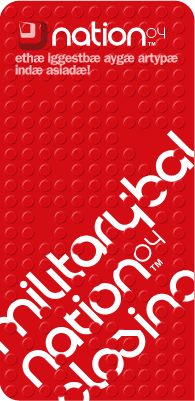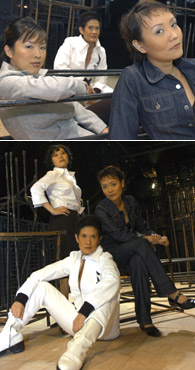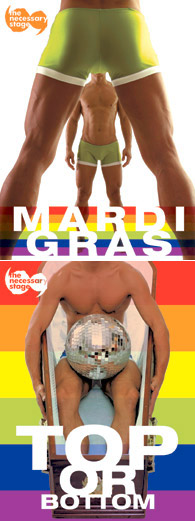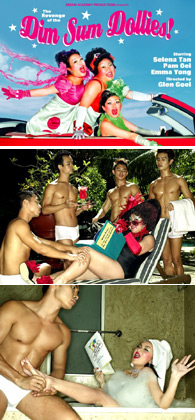This article first appeared on Kakiseni.com (http://www.kakiseni.com), a Malaysian online arts magazine and is reproduced with permission.
Heard of the pink dollar? It's the latest trans-national currency. It's not actually pink in colour, and denominations don't come in the form of queer three-dollar bills, but the purported ability of the pink dollar to cross territorial borders makes the Euro seem like last century's news. Some people consider the pink dollar the stuff of myth, and quite rightly too: its origins are founded on stereotypes. Apparently, gay people represent the next frontier of the global consumer - they are well-educated, have professional vocations, have no spouses and children to support, and thus have much disposable income, which they secretly wish to fritter with wild abandon the way Madonna does in that scene in Evita where she throws fistfuls of dollar notes from a moving train. Their spending power is limitless, directed mainly towards industries promoting hedonism and vanity, which I will inventorise as the five High C's - Creatine supplements, Cosmetics, Circuit parties, Check-ins and Culture. To these ends they will travel to far reaches of the world - sun-tanning in St Tropez, snorkelling in Mykonos, exotic fishing (ahem) in Bangkok (how smooth they are!) and Casablanca (and how brown!).

The Nation Party this year stretched from August 7 to 9. To quote from the website: "This year, an attendance of between 8,000 to 10,000 is expected, of which up to 2,500 are tourists, making it the largest event of its kind in Asia. The 3-day event, which cost about S$500,000 to produce, is expected to generate close to S$10 million in tourist revenue, based on unreleased data collected by an independent market research company at Nation in 2003. The study also showed that gay visitors had a per capita spend more than ten times the national average."
In addition to being 'the largest Nation party ever', there was also an informal 'Nation Arts Programme'. This included a tie-up with local theatre companies, which presented the following offerings: Mergers and Wills (Toy Factory) in Mandarin, Top or Bottom and Mardi Gras (The Necessary Stage), and The Revenge of the Dim Sum Dollies (Dream Academy Productions).
The phenomenon of the gay play in Singapore is not new; as a matter of fact the past few years have witnessed an explosion of gay-themed plays in local theatre. Notable ones include The Eleanor Wong Trilogy (W!ld Rice), Bent and East Side Story (both by Toy Factory) as well as Existence (The Fun Stage). What seemed novel was how the plays for the 'Nation Arts Programme' were packaged together and jointly promoted to a potential audience assumed to be carrying suitcases of the elusive and coveted pink dollar. Of course gay plays have been courting their affluent niche market for a long time, but the difference in this case is that sights were also being set on the international front.
I attended all the plays, with the exception of Mardi Gras (I was at the KL literary festival at the time), and a few questions struck me. In courting the economic potential of their imagined audience, in what ways did the plays 'play up' the 'gayness' of their material? How much did they try to articulate an indigenous gay identity, in the face of capitalist global gay signifiers like 'pink' and the 'rainbow flag'? At which point did such gestures take a turn towards the political to challenge permissible boundaries? Can theatre ultimately restore the political to a nascent gay movement, especially since the Nation party itself is nothing more than a spectacularisation of gay identity (buffed men on podiums twirling lightsticks), devoid of critique, and whose legitimacy is latched on to the logic of tourist dollars?
Mergers and Wills
A caveat, first of all. I don't understand Mandarin. Not a word.

Wong's two plays are seminal simply because they are the only plays to date which are based on the lesbian experience in Singapore. One cannot overstate the importance of such avenues of representation, especially when one deals with the lesbian community, which is somewhat less visible than its gay male counterpart. Lest this smacks too much of tokenism, I have to also say that the sizzling dialogue and the full-bodied characters also make the plays a richly rewarding theatrical experience.
Wong's plays have sometimes been criticised for adopting a naturalistic form, which some critics argue are patriarchal and heterosexist. The rationale is that the lesbian play should not only be an exploration of content, but should also propose newer and more radical forms to challenge the tyranny of bourgeois psychological realism. I don't completely agree with such Marxist-Feminist claims, but Toy Factory's staging seemed to be aware of such criticisms, to the effect of offering a rather stylised production.
Goh Boon Teck's set design consisted of metal rods twisted into amorphous shapes: at various times they represented cages, or the scaffolds of furniture. A backstage area was screened by a wall of perforated plastic crates, which allowed for some scenes to be played in silhouette. Some of the more stylised elements in the play include characters swinging a naked light bulb like a pendulum, slow walking down a catwalk while delivering a monologue, and re-arranging the set. I personally felt that while visually poetic, these self-consciously theatrical interventions somehow strayed from the particular naturalistic universe contained in the texts.
The acting, if I can possibly comment on acting based on my observation of non-verbal elements, was convincing and charged at many points with a delicate understanding of pace and subtlety. The lead character, a 'chain-smoking lesbian lawyer' called Ellen Toh, is not an easy character to play. In the first play, she has to go through a marriage of convenience before finally facing up to her real desires.
In the second, she has to carry even heavier responsibilities: as caregiver to her father and her dying lover, while at the same time crossing swords with her conservative Christian sister. It is to the lead actress' (Leanne Ong) credit that the role was handled with quiet fortitude, ably supported by the ever-reliable Karen Tan and Serene Chen as her lover and sister respectively.
In the final scene, a voice-over is played, while Grace, Ellen's sister, hits a towering black-and-white portrait of Frida Kahlo (The Broken Column, 1944) with a red shoe. It is at this point that the directorial treatment became mystifying. In the original text, the last speech was delivered by Grace, and it spoke largely of her reconciliation with Ellen and her peaceful acceptance of her sister's sexuality. This particular resolution, perhaps too pat, was challenged in the Toy Factory version, with the image of Grace assaulting the portrait.
Maybe Grace was practicing a kind of iconoclasm, reacting against the more rigidly orthodox aspects of her faith. But why then pound against an image of the famed Mexican artist who has herself been claimed as a lesbian icon (Kahlo was a known bisexual)? There was an interesting tension between Wong's naturalism and Toy Factory's stylisation that maintained throughout the play. In this final scene, however, that taut thread snapped, sending the playwright and the co-directors (Goh Boon Teck and Nelson Chia) into divergent orbits, and myself into a space of limbo.
Top or Bottom
Top or Bottom is the sequel to Mardi Gras, the latter a play which depicted the struggles of a group of gay and lesbian friends who try to organise Singapore's first (gay) Mardi Gras street-march. In Top or Bottom, one of these friends has passed away, and the play examines how the characters deal with grief.

In Top or Bottom, we follow the journey of Faith (Hossan Leong) as he comes to terms with the death of his best friend, Clement. We aren't informed of the cause of his death, which is a good thing, since this effectively throws two tired 'gay themes' - AIDS and suicide - out of the window.
The play opens with a scene of a coffin brought into the living room, and the audience anticipates the anguish of confronting death in your very own house. The other characters enter, including Hope, Faith's transgender boy/girlfriend (Kumar) and Su Merican, a shrill fag hag who's also a single mother (Natalie Hennedige). There is also Clement (Rody Vera), in the form of a ghost, who only Faith can see.
However, instead of the expected mood of solemnity, the audience is served with irreverence. The characters engage in bitchy repartee, loaded with innuendoes, accessorised with requisite finger snapping and eye-rolling. The coffin on stage, so obvious to the audience, recedes into the background - partying and shopping are recommended as therapy, and it seems as if everyone is ready to just 'get on' with their lives.
I would hesitate from making sanctimonious prescriptions on how people should grieve. But there lingered the possibility of making essentialist connections between the ability of the characters to display genuine feelings of sorrow and the fact that they were gay. It was admirable that the play was not just a vacuous celebration of gay culture and identity, whitewashing its warts and all. However, the stance that was adopted seemed to veer towards the other extreme, where there was merciless self-flagellation of the gay species: its frivolity, its self-absorption, its inability to deal with real human crisis.
Faith embarks on a process of furious soul-searching throughout the play, at one point even contemplating the idea of performing relief work in rural Thailand. He wonders, while considering his own mortality, whether he has really made a difference to anyone's life. Along the way, we also get a critique of gay militancy, when the characters' attempts to deride Brian's (Paerin Choa) decision to turn straight is exposed as being as cruelly oppressive as any brand of heterosexism.
The play is constructed mostly as a series of flashbacks, where we get a glimpse of the friendship between Faith and Clement, and can thus decide whether the dynamics of their relationship provided the foundations for a right and proper mourning. There are many stylised segments, including a parody of a dysfunctional family, a mock-up of the Miss Universe pageant and a hilarious musical number featuring Hope and Clement as Barbra Streisand and Elton John.
There is no doubt that the play was entertaining, and that all the actors were uniformly up to the task of delving into the play's complex themes. The main problem I had with Top or Bottom was that it walked a very fine line between self-criticality and self-loathing. Sure, spare us the heart-tugging saints and the wronged victims, but are unsympathetic navel-gazers the only honest alternative?
As if to address the nagging concerns I had throughout the play, the ending scene replayed the first scene, but with hues that were more appropriate for a funeral. The characters were quieter, their expressions suitably grave. None of the vulgar impertinence in the first scene, the mocking hysteria. And yet, I asked myself, did this scene, played out almost like a recantation of the previous one, come closer to an emotional truth? The characters had every right to grieve as they saw fit, not because they were gay and possessed a unique and flippant way to grieve, but because they were, the last time I checked, human.
And this, for me, was playwright Haresh Sharma's triumph and the intractable source of my ambivalence. The radical assertion made in Top or Bottom is not the one we are used to: that gay people are like other people by virtue of the fact that they fall in love and get hurt and demonstrate kindness, etc. No, gay people can be ugly, and vicious, are susceptible to all kinds of failings, and don't always rise to the occasion. Just like other people.
The Revenge of the Dim Sum Dollies
Of the three plays, Revenge was the one that did not explicitly address gay issues. However, it was about three colossally talented broads on stage belting out show tunes, accompanied by six hunky male dancers. If you ask me, that's about as close to gay as you can get - both diva-and body-worshipping in one fell swoop.

There were also segments which effectively managed both pathos and comedy with equal finesse. One particular segment, 'Maids in Heaven', had the Dollies as Filipino maids in a fog-filled heaven. Apparently, all of them had died after falling off ledges while cleaning their employers' windows. There has been an alarming trend of such accidental deaths in Singapore in the past year, and when the audience laughed, it was laughter laced with hurt. This was an instance, so prized in theatre, where one could provoke such contradictory emotions. Kudos to the production that it was sprung during a performance modelled after a harmless cabaret.
However, the parodic mode that permeated the sketches - ranging from send-ups of Malay parking attendants, tai-tai's, schoolgirls and senior citizens - did not last the whole evening. The climax of the show proved to be anticlimactic for me, even though it boasted loud pyrotechnics and a giant Singapore flag. Or perhaps I meant 'because' and not 'even though'. The ending saw the Dollies enacting familiar National Day tropes: singing official lyrics to official songs, with the male dancers discarding their go-go theatrics for rousing marching-steps in uniform - as fireman, soldier, policeman.
As a valentine to female empowerment, the Dim Sum Dollies scored full marks; as political satire it fell slightly short. The ending seemed to be a case of back-pedalling, where offering the State a conciliatory hug seemed to be the price to pay for some of the liberties taken in the earlier parts. Take on the National Day spectacle, by all means, but put some extra into the extravaganza. Instead of the usual contingent of civil servants, why not add a few Mat Rockers, Ah Beng's, drag queens? Tamper with the songs, spoof the slogans. By treating the symbols of National Day with such compliant reverence, the Dollies signalled zones beyond the reach of satire. For the moment at least, Malaysia's own Instant Caf� Theatre has little to fear.
To the credit of all three performances, none seemed to buckle to any pressure to 'internationalise' their contents - probably because they realise that the bulk of their audiences would be from the home crowd anyway. Circuit parties have the tendency to put the 'homo' into the homogenous - the same bodies, the same tight clothes, the same dance moves, the same anthems, from Ibiza to London to Tokyo. There is little wonder why the buffed-up party-hopping gay man is called the 'clone'.
The Nation Arts Programme, even if it is unofficial, allows local gay identities to resist Western monoculture. There is much promise, if this project of self-representation that finds its birth in theatre is followed through: one day we'll replace Barbra and Elton with Anita Sarawak and Leslie Cheung. And even if we're chasing the pink dollar, we'll learn to ask for a specific shade: bandung pink please, thank you very much.
Alfian Sa'at is a published and award-winning poet, playwright, short-story writer and medical undergraduate. This article first appeared on Kakiseni.com (http://www.kakiseni.com), a Malaysian online arts magazine and is reproduced with permission.











 Printable Version
Printable Version










Reader's Comments
Be the first to leave a comment on this page!
Please log in to use this feature.